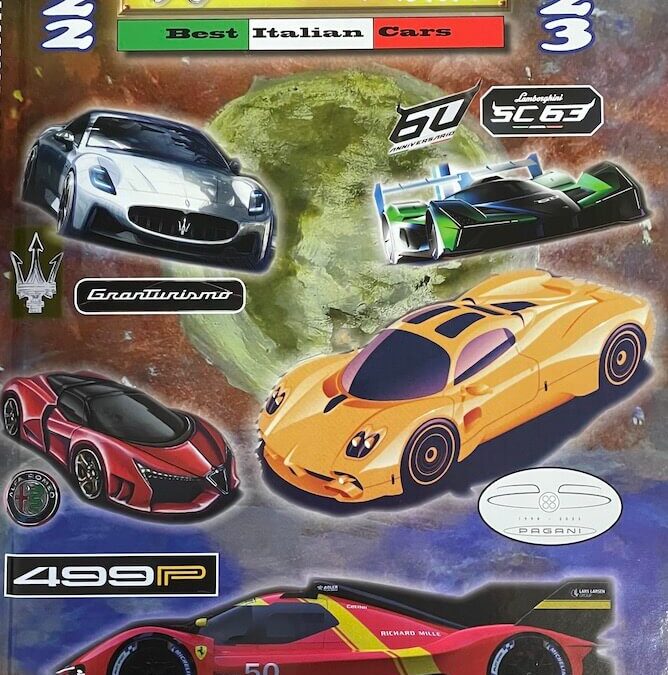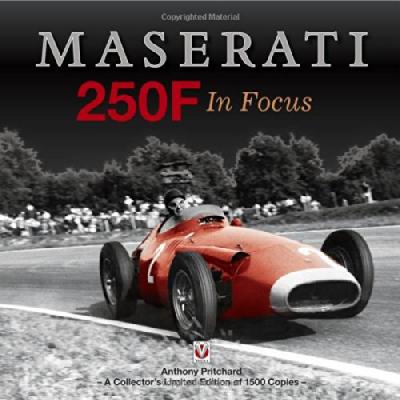
“Competing throughout the 2500cc Grand Prix Formula years of 1954-60, the Maserati 250F is one of the most famous and iconic racing cars ever built. Maserati 250F In Focus is one of the most detailed accounts ever written about a single model, and this superbly illustrated book features photographs by Tom March, one of the 1950s leading motor racing photographers, along with historic engine cutaways, chassis drawings, and technical descriptions of the 250F’s evolution and development.
Anthony Pritchard’s lively and informative text includes reminiscences from some of the leading drivers of the day, including Sir Stirling Moss, Juan Fangio, and Mike Hawthorn – drivers who raced these historic machines during the halycon days when Maserati battled with Ferrari, Mercedes-Benz, and Vanwall for Grand Prix supremacy.
From the 1954 Argentine Grand Prix, to the 1960 US Grand Prix, a record of the chassis and race numbers of every 250F to have competed during this period is presented, along with detailed race histories and results, completing this most comprehensive and authoritative of books on Maserati’s racing legend.”

A historical tour in more than 100 images of the car as both subject and creative force in photography.
Undeniably one of the most influential innovations of the modern world, the car has changed not only the way we live, but also the way we look at the world around us. From formal, compositional device to highly desirable, photogenic object, the car has a long and enduring appeal in modern and contemporary photography as revealed in this latest addition to the V&A Photography Library.
Autofocus explores the deep cultural significance of the car in the history of photography, playing a role both as subject matter and as a genuine creative vehicle―the means by which photographers have accomplished many of their great works. Showcased is work by Henri Cartier-Bresson, Walker Evans, Robert Frank, Edward Weston, and Weegee.
This captivating album presents more than 100 photographs, alongside fascinating commentaries and an introduction, that span the early years of the automobile to the present day. For both photography and car-loving audiences, Autofocus illustrates the inexorable rise of the car as a cultural icon.
100 illustrations

When world rallying introduced a new formula for “World Rally Cars”, Ford seized the opportunity. Malcolm Wilson’s M-Sport organization was contracted to do the job, completed the design in less than a year, and spent the next 12 years campaigning this turbocharged, four-wheel-drive car all round the world.
Working from state-of-the-art facilities, M-Sport built 97 Focus WRCs, all of which proved to be worthy of World level action when they won 44 World Championship events.
Stellar drivers like Colin McRae, Carlos Sainz, Markko Märtin, Marcus Grönholm and Mikko Hirvonen all added to the mystique of an ultra-professional organization, along with substantial support and sponsorship from the likes of Martini, BP, and the state of Abu Dhabi.
By building its in-house technical expertise, M-Sport not only engineered and developed the entire car on behalf of Ford, but gradually took over development of the 300bhp, 2.0-litre, turbocharged engine, and led the design of the complex four-wheel-drive transmissions provided by Xtrac.
M-Sport’s reputation exploded to the point that when regulations changed, the company immediately produced a new-generation Fiesta WRC, and kept the winning days rolling.
HAYNES
HAYNES
Street Tuner Focus

Lightning Strikes—The Lockheed P-38 tells the full story of one of the most successful and versatile aircraft of the Second World War. The P-38 (including its F-4 and F-5 photo reconnaissance models) eventually served with all the USAAF’s numbered overseas air forces, from early 1942 to VJ Day. The book describes the Lightning’s design and its technical details as it gradually evolved and improved, from the original XP-38 to its final variant, the P-38L-5. The main focus is on its service in the combat theaters, from the frigid, windswept Aleutian Islands in the North Pacific to the steaming jungles of the South Pacific and Southeast Asia, the burning sands of North Africa and the more temperate climes of Europe. All the units that flew the Lightning are included, as are the experiences of many of their pilots and ground crewmen as they fought the Japanese Empire and the European Axis. Also related are the P-38’s service with foreign (non-U.S.) air forces, its postwar commercial utilization as civilian aircraft and the surviving examples in museums around the world. The book is extremely well illustrated with nearly 400 high-resolution photographs, artworks, and graphics, and is supplemented by detailed appendices.
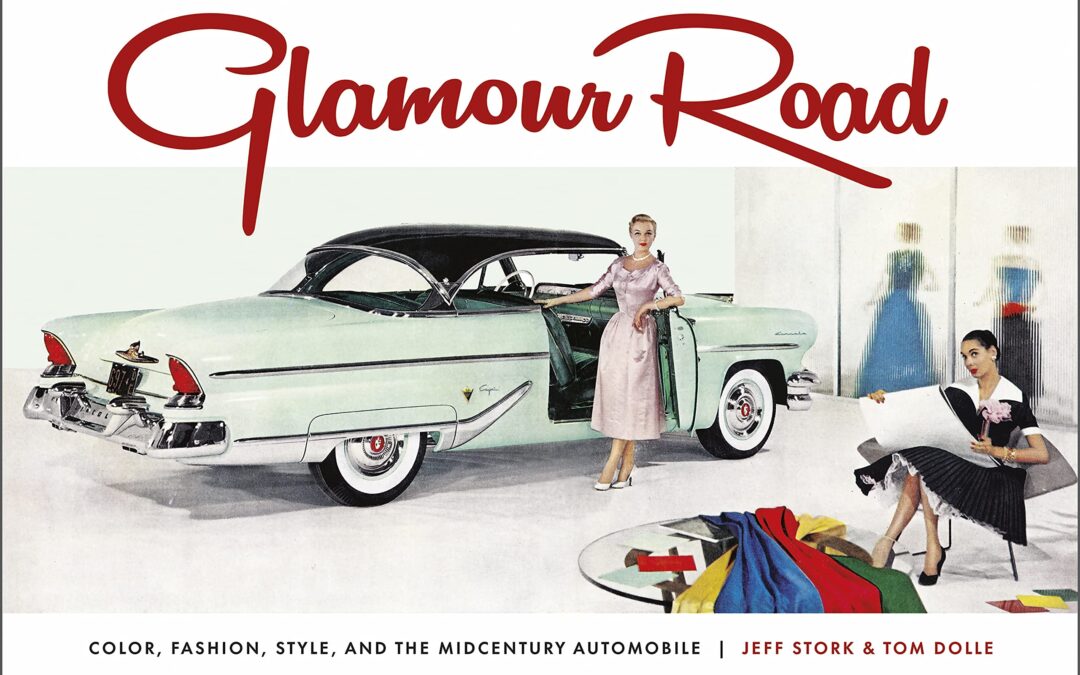
SOLD OUT AWAITING PUBLISHER RE-PRINT
This highly visual book explores the seldom-told story of how glamour, fashion, design, and styling became the main focus of automotive marketing from the postwar 1940s through the 1970s. With the expansion of the American suburbs after WWII, women suddenly needed cars of their own. By adopting the fashion industry’s yearly model changes, as well as hiring many designers and stylists from the fashion industry, the automobile industry made a direct appeal to the rising sophistication and influence of women. By perfecting the fashion-centric concept of planned obsolescence, it became the dominant economic engine of American postwar prosperity. The dramatic photography, elegant fashion, and use of color and materials in midcentury automotive marketing created a groundswell of demand for new cars. Much of the marketing imagery of the period hasn’t been published since it first came out, and this book features some of the best.
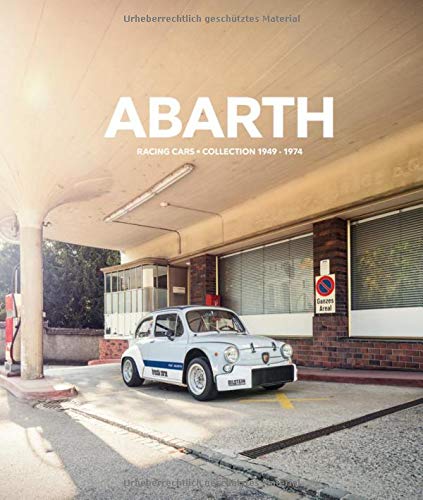
- The complete history of Abarth race cars
- Previously unseen pictures and documents
A spectacular collection of 48 Abarth race cars, covering the whole production period, with lavish pictures by top photographers, makes for a very exciting book. The author has access to huge archives, one from a former race mechanic, with lots of letters, documents and historic photos.
The pictures are the main focus here, interspersed by anecdotes from the golden times of motor racing.
Text in English and German.
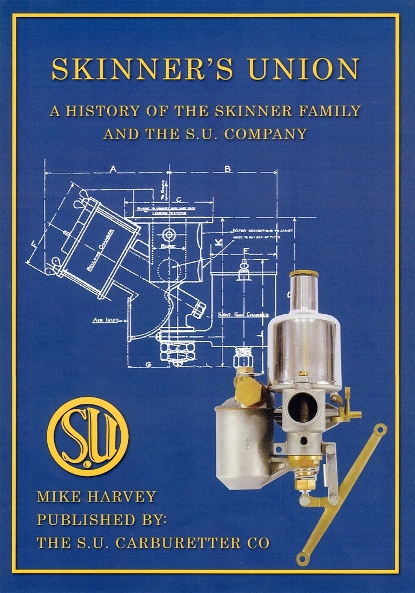
Skinner’s Union – A history of the Skinner family and the S.U Company is a comprehensive history of the S.U. Company and the members of the Skinner family involved. This new book by Mike Harvey comprises over 300 pages with copious photographs, drawings and illustrations (many not previously published).
The book’s main focus is on the period from 1908 when the leather bellows carburetter,designed by George Herbert Skinner, was first put into production by his younger brother Thomas Carlyle Skinner (whilst originally a partner in the firm of George Wailes & Co), through to Carl Skinner’s retirement in 1947, by which time the S.U. Carburetter Company Ltd was part of the vast Nuffield Organisation.
Two chapters cover Barbara and Peter Skinner’s hill climbing and racing activities and give details of the Skinner Specials. Another chapter covers the period leading up to and during WW2, when SU manufactured the aero-carburetters and single point injection systems for many RAF aircraft. During the Battle of Britain in 1940, the Rolls-Royce Merlin engine in every Spitfire and Hurricane had an SU Carburetter. Two Appendices cover the the history of the company from the 1950’s to the present day and list the main S.U products from the first prototype carburetter of 1904 through to 1994 when the original company ceased manufacturing the KIF carburetters for the Rover Metro. A further Appendix lists details of the original patents and drawings.

The Pan American clipper ships of the 1930s and 1940s were technological marvels of their time. The years before World War II found the United States faced with international challenges of an economic as well as a military nature. Aided by government regulations and contracts, the Pan Am clippers were, for a time, the only international craft to carry the U.S. flag. Commercially, they rivaled the comfort and popularity of passenger trains and luxurious cruise ships. Militarily, they were unmatched by anything the Germans, Russians, Italians or French could produce. The only long-range aircraft capable of carrying transoceanic payloads, clippers became instantly valuable with the onset of the war. Marketed as the ultimate in commercial–or military–airfare, these flying boats became as much an American icon as the Pan Am logo itself. From the movie screen to the bookshelf, this volume examines the multitude of ways in which the values inherent in Pan American Airways’ clipper ships played out in popular culture. The book discusses the strategies Pan Am used to represent the clipper as a paragon of U.S. interests, values and beliefs. Mirroring the moods of the times, the clipper became a consistent American icon, being associated with the Statue of Liberty and the American eagle. The main focus of the work is the variety of ways in which this iconographic status manifested itself through toys, movies, pulp fiction, comic books and music. Clipper influence is also examined in other unlikely places such as the name of an available car color, car models, restaurant menus and lounge names. An appendix explains different models of the clipper flying boats.
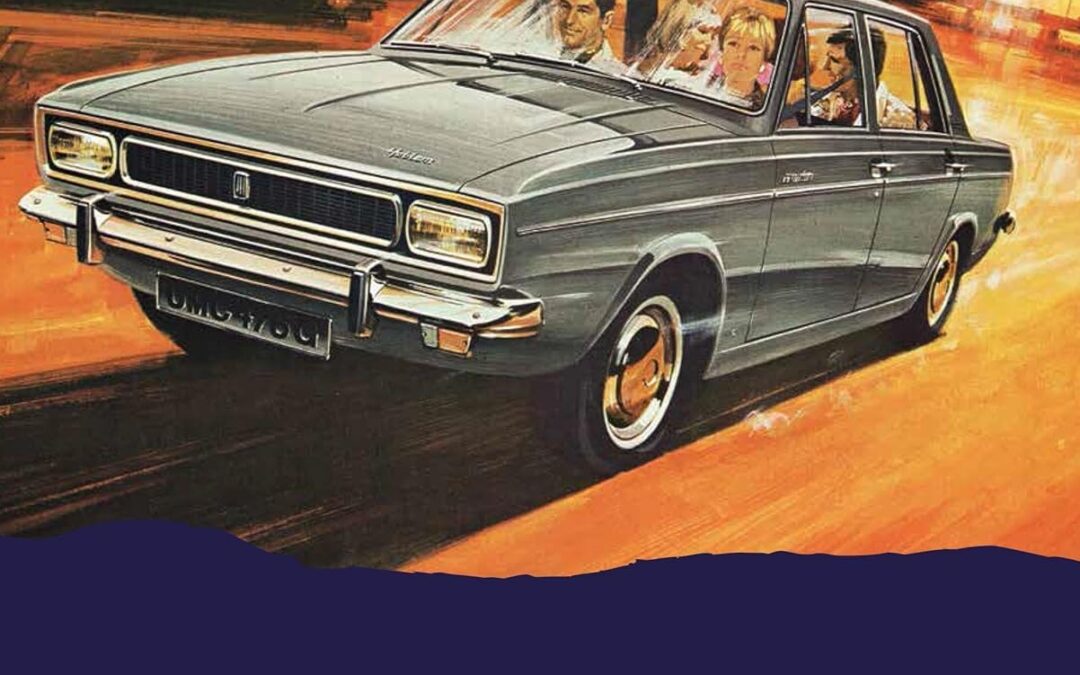
The Rootes Story – The Chrysler Years focuses on the Rootes Group during the 1960s and 70s, the vehicles, the people and the events that led to Rootes selling out to Chrysler Corporation of America and eventual acquisition by the French Peugeot company. A valuable backdrop to the events is provided throughout the book by ex- Rootes employees and management. Chronicles the Rootes Group’s efforts to survive as a major car and truck manufacturer in Britain’s turbulent 1960s and 1970s. From a position as a respected global name in manufacturing, the Rootes Group found itself struggling to compete in a new buyers’ market. Despite the challenges that confronted them, Rootes designed and built some of the most popular cars of the period: the Hillman Minx, the Singer Vogue, the Humber Sceptre, and the iconic but ill-fated Hillman Imp, as well as some of the most rugged and well-purposed vans and trucks, built by Commer, Karrier and Dodge. Famous names such as Paddy Hopkirk, Rosemary Smith and Peter Procter all give their stories as works drivers for Rootes, while engineers at ‘comps’ tell the background stories of how races and rallies were won and lost. Andrew Cowan, Rootes’ works rally driver and winner of the 1968 London–Sydney Marathon in a Hillman Hunter, shares his story in what was a remarkable and unexpected victory for Rootes. Geoff Carverhill takes you inside the boardroom, into the drawing office and on to the production line to give the reader an insider’s view of Rootes, Chrysler and Peugeot.

In over 50 years as a renowned motoring journalist and racing driver, Jeremy Walton has driven many, many hundreds of performance cars, but Fords have always been prominent among them and particularly close to his heart.
He was on the scene when fast Fords arrived in the early sixties alongside the Blue Oval becoming serious about motorsport. He has tested almost every significant performance derivative ever since, many straight from Ford’s competitions department. From Cortinas to Capris, Escorts and Sierras, via the epic GT40s to extraordinary Transit Supervans and into the new Millennium with Mondeo, Focus and Fiesta, Walton was there.
- Populars and Anglias: the ‘Berpop’ club racing special; Harry Potter boosts Anglia’s global fame; future Grand Prix talent within Roger Williamson’s Anglia; World Champion Graham Hill’s speedy Goodwood endurance week.
- Cortinas in all their variety: from the ex-Jim Clark British Saloon Car Championship winner to the author’s later BRM-tuned Cortina Lotus, plus three Uren-modified Savage V6 legends.
- Ford GT40s: driving experiences of two factory-owned examples, a pair of modern tributes and a privately owned example in Gulf colours.
- Supervans: Ford’s three generations of ludicrously fast Transits, variously with GT40 and Cosworth V8 engines.
- Rear-drive Escorts: numerous competition versions, including internationally celebrated RS1600s raced by John Fitzpatrick and rallied by Timo Mäkinen.
- Capris in profusion: all generations tested and raced, including the unique story of a 3-litre driven by Royalty and a triple World Champion; tales from the British Touring Car Championship, infamous ‘celebrity’ events and Belgium’s classic Spa 24 Hours.
- Front-drive Escorts: more racing experiences, Princess Diana’s immensely valuable Escort RS, plus a trio of wild rides in 550bhp turbocharged four-wheel-drive rallycross versions, setting records for electronically timed 0–60mph sprints.
- Sierras of many shades: from XR4i and XR 4×4 to Cosworth and RS500, including extensive racing, plus a winning factory World Rally Championship RS and the inevitable stolen road-test Cosworth RS.
- Works Escort Cosworth and Mondeo: still testing Ford’s finest into the 1990s, including two generations of Focus RS and Fiesta ST.
- American hearts: experiences with V8 Mustangs, Falcons and Thunderbirds, including a thundering NASCAR ‘T-Bird’ track test.
- American hearts: experiences with V8 Mustangs, Falcons and Thunderbirds, including a thundering NASCAR ‘T-Bird’ track test.
Presenting his extraordinary expertise and experience in his trade-mark colourful writing style, he puts the reader in the driving seat for a rollercoaster of exciting rides. Any enthusiast who has ever enjoyed a fast Ford will love this entertaining feast of nostalgia.

Celebrate Formula One’s most iconic drivers with this exploration of their triumphs and tragedies. Featuring high-quality photography and insight from renowned F1 journalist Tony Dodgins.
At the heart of Formula One lies the triumphs and tragedies of the sport’s greatest stars. The drama, personality and thrill of the sport are all tied to the cult drivers who have made racing so great to watch. Only the fastest and bravest survive!
With a foreword by Christian Horner, Team Principal of Red Bull Racing, Formula One: The Legends profiles 32 of F1’s iconic drivers from the 1950s to the present day. As well as examining the racers of the past, such as Jackie Stewart, Alain Prost and Aryton Senna, the text profiles modern-day legends such as Sebastian Vettel, Lewis Hamilton and legend-in-the-making Max Verstappen.
Uniquely, this book also features stars of the sport who tragically died or were terribly injured before they could realize their true potential, but nevertheless left a lasting legacy.
Decade by decade since the championship was founded, this book profiles the following legends of F1: Ascari, Fangio, Moss, Hawthorn, Brabham, Graham Hill, McLaren, Gurney, Surtees, Clark, Stewart, Rindt, Andretti, Fittipaldi, Lauda, Hunt, Jones, Gilles Villeneuve, Piquet, Prost, Mansell, Senna, Häkkinen, Schumacher, Damon Hill, Button, Alonso, Räikkönen, Rosberg, Vettel, Hamilton, Verstappen.
This is a unique exploration of Formula One racing, with a focus on the most revered Formula One drivers of all time. A standout gift for fans of the sport, this collection includes expert photography to highlight the greatest moments of these drivers’ careers. Fascinating and insightful, with informed voices from the sport, this is a collection not to be missed.

Celebrate and explore 100 years of MG cars with this impressive volume featuring expert commentary, historical images, period ads, and contemporary photography.
For many car enthusiasts, MG is synonymous with “sports car.” It is often credited with igniting a passion for European cars in postwar America at a time when roads were otherwise filled with the lumbering output of Detroit. In MG’s native England, the company’s cars filled roles from family transport to competition driving.
MG, as we think of it today, began in the 1920s, but its roots go back even further with a young William Morris. Initially working in the booming bicycle trade, he eventually branched into motorcycle and car repair with the fledgling Morris Garage (hence, MG) in 1907. By the mid 1920s, the successful Morris Garages was in a position to begin manufacture of its own cars under the MG name.
MG grew significantly in the years before World War II, building and racing its classic Midgets and Magnettes. World War II provided challenging times for the company as it did for the UK and much of the world. In the postwar period, a focus on sales outside England, and particularly in the United States, both defined MG’s product line and ensured its success. Legendary cars followed, including MG TC, TD, and TF followed by thoroughly modern MGA, MGB, MGB GT, and Midget. Magnettes and the 1100 offered options for those wanting sedans and more practical cars.
MG ownership moved through a number of UK companies in the postwar period as well as ownership by BMW and today’s SAIC, a Chinese-based company through which it operates as MG Motor. Highlights along the way included the MGB GT V8, MG Metro Group B rally car, and MGF. Based on its latest state-of-the-art EV platform, MG will soon launch an all-new roadster coming full circle over its century in business.
Authored by marque expert David Knowles, The MG Century: 100 Years of Safety Fast! is a fitting celebration of one of the automotive world’s oldest and most beloved brands—and a must-have for every car enthusiast.
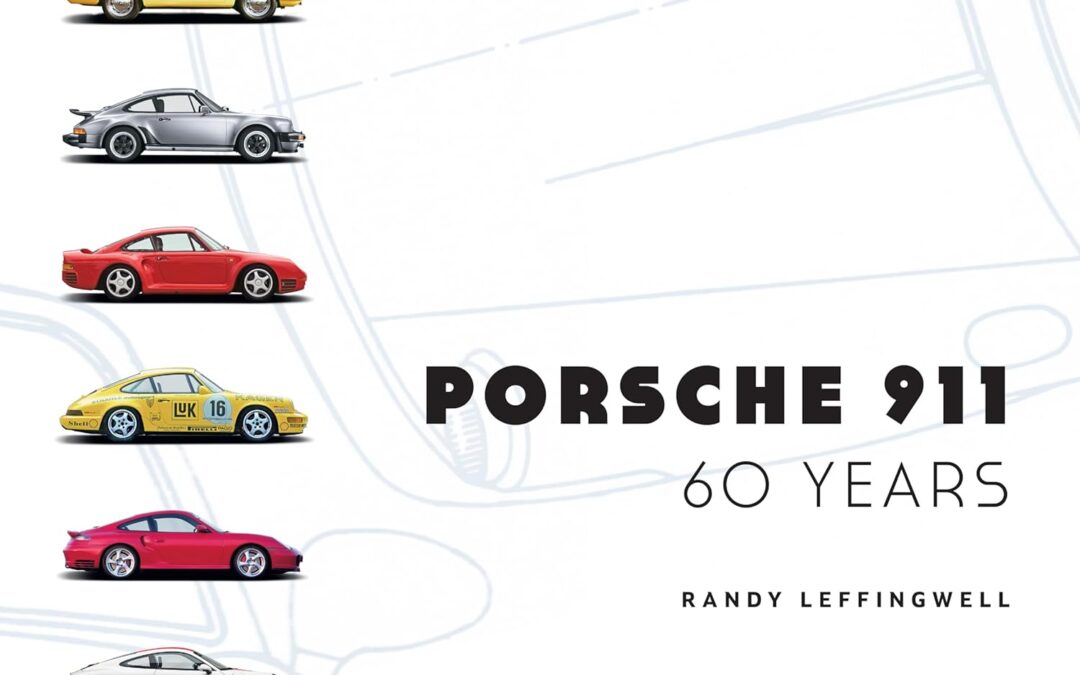

Updated from its previous format to include the later 3.2 Litre models through 1989. This Floyd Clymer publication includes complete technical data, service and maintenance information and comprehensive detailed instructions for the repair and overhaul of all major and minor mechanical and electrical components for the 1973 to 1989 Porsche 911G Series, 2.7, 3.0 and the 3.2 Litre models.
In its original format, this manual covered the Porsche 911 models through the 1978 model year. However, additional information for the earlier 2.7 and 3.0 Litre models that was not available at the time the original manual was published, is now included or appended to each chapter in this revised publication.
While this manual focuses on the 1973-1989 G series 911, much of the information is also applicable to the earlier 2.4 Litre (1971-73) models destined for the U.S.A., Australia, Japan and Canada that, due to emission requirements, were fitted with Bosch mechanical fuel injection (FIP). Consequently, this manual will also be of interest to owners of those 2.4 litre fuel injected models.
The manual is broken down into the following sections: Engine, Fuel System including Bosch mechanical fuel injection (FIP) continuous injection (CIS) and digital fuel injection (DME). Ignition Systems including Capacitive Discharge CDS, CDI and DME, Cooling, Heating & Exhaust Emission Systems, Clutch, Manual Transmission & Sportomatic Transmission, Rear Suspension & Drive Axles, Front Suspension, Steering, Brakes, Electrical System and Body. There is also an appendix to the rear of the manual that includes Technical Specifications and Wiring Diagrams.
While reprints of the factory manual are readily available, they are relatively expensive and we are pleased to be able to offer this reasonably priced alternative as a service to all 1973-1989 Porsche 911 enthusiasts worldwide.
248 pages, 311 illustrations plus an additional 66 pages of wiring diagrams, size 8.25 x 10.75 inches

Nash-Healey – A Grand Alliance examines in exquisite and exacting detail the story behind America’s first postwar sports car and the unique Anglo-American partnership between Nash and Healey that gave it life, which became an international triumvirate with the later involvement of famed Italian coachbuilder Pinin Farina.
Focusing on the lives and careers of the men behind these fantastic machines, this book dives into their prior accomplishments, before reviewing the design and development of the Nash-Healey roadsters and coupes. It also explores the marque’s incredible competition record at iconic races like the Mille Miglia, 24 Hours of Le Mans and Alpine and Monte Carlo rallies. Lavishly illustrated with almost 1,200 images, most never before published, including several from Donald Healey’s own personal photographic collection, this book is essential for all Nash-Healey enthusiasts and fans of sports cars from the breed’s golden era.
- 2-volume set in slipcase
- 800 pages
- 1,192 illustrations
- Foreword by Donald Osborne
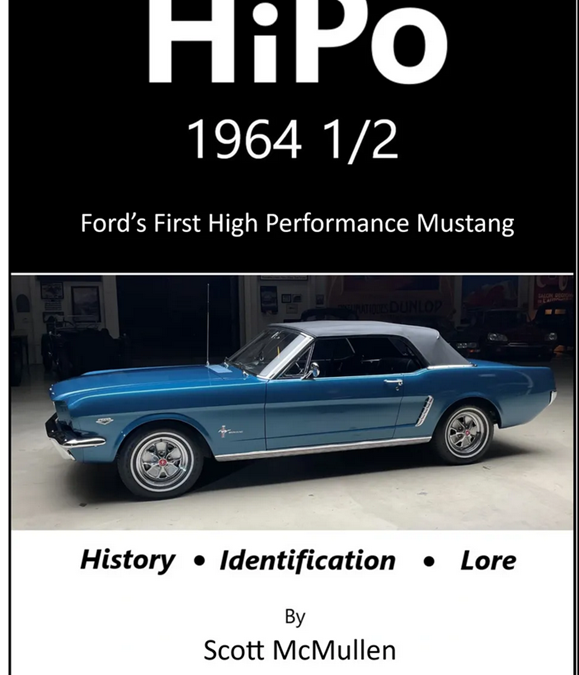
Introducing “HiPo 1964 1/2 Ford’s First High Performance Mustang – History, Identification, Lore”. Dive into the thrilling world of Ford’s iconic 64 1/2 K code Mustang with captivating stories and stunning visuals. A must-have for every auto enthusiast!
The authoritative guide to Ford’s original street legal race-bred Mustang and one of the world’s rarest collector cars, whose fascinating story is sure to entertain a wide range of automotive enthusiasts – not just Mustang fans – covering history, early prototypes, development/testing, production, characteristics/parts, restoration/preservation, and much more. (Hardcover, 347 pages, 157 photos/images both color and black & white.) By Scott McMullen with foreword by Jay Leno.
“HiPo 1964 ½ Ford’s First High Performance Mustang” focuses on one of Ford’s rarest production cars – rarer than the 1965-1966 Shelby GT 350 and the only option for Mustang performance buffs prior to August 1964. Also known as HiPos or K codes, most enthusiasts are aware of the 65-66 models, but little about the 64 ½ HiPo Mustangs, has been available. The 64 ½ cars were the original embodiment of the street legal race-bred Mustang. Their fascinating story is sure to entertain a wide range of automotive enthusiasts – not just Mustang fans.
The book includes rare, and in some cases, never-before-published pictures of early High Performance Mustang prototypes and pre K code mustangs production cars. Included are details of experimentation and production along with in-depth discussions of how research and development progressed through the start of 64 ½ K code production up to the start of 65 production. Also explored is the lore of these classic muscle cars and the test drivers, like Dan Gurney, who helped wring them out.
This information is invaluable to the collector and automotive performance enthusiast alike. Even the most knowledgeable Mustang aficionado will find new information, some of which will challenge old notions and lore that has been told through generations of Mustang fans the world over. The book goes on to present tips for preserving and restoring a 64 ½ HiPo Mustang. It further delves into characteristics of an authentic 64 ½ K code Mustang along with how they changed through the few weeks in 1964 that these ultra rare cars were produced.
Hardcover, 347 pages, 157 photos/images both color and black&white.
















